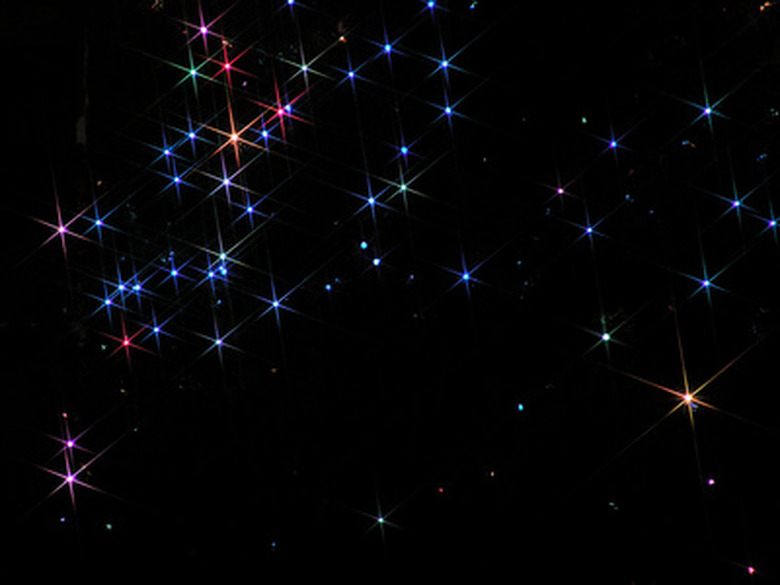How To Calculate Stellar Radii
If you think you can't measure the radius of a star directly, think again, because the Hubble telescope has made many things possible that weren't before, even that. However, light diffraction is a limiting factor, so this method works well only for large stars.
Another method astrophysicists employ to determine a star's size is to measure how long it takes for it to disappear behind an obstacle, such as the moon. The star's angular size θ is a product of the obscuring object's angular velocity (v), which is known, and the time it takes for the star to disappear (∆t):
\(\theta = v\times \Delta t\)
The fact that the Hubble telescope orbits outside the light-dispersing atmosphere makes it capable of extreme accuracy, so these methods of measuring stellar radii are more feasible than they used to be. Even so, the preferred method to measure stellar radii is to calculate them from luminosity and temperature using the Stefan-Boltzmann Law.
Radius, Luminosity and Temperature Relationship
Radius, Luminosity and Temperature Relationship
For most purposes, an star can be considered a black body, and the amount of power P radiated by any black body is related to its temperature T and surface area A by the Stefan-Boltzmann Law, which states that:
\(\frac{P}{A}=\sigma T^4\)
where σ is the Stefan-Boltzmann constant.
Considering that a star is a sphere with a surface area of 4πR2, where R is the radius, and that P is equivalent to the star's luminosity L, which is measurable, this equation can be rearranged to express L in terms of R and T:
\(L = 4πR^2σT^4\)
Luminosity varies with the square of a star's radius and the fourth power of its temperature.
Measuring Temperature and Luminosity
Measuring Temperature and Luminosity
Astrophysicists gain information about stars first and foremost by looking at them through telescopes and examining their spectra. The color of light with which star shines is an indication of its temperature. Blue stars are the hottest while orange and red ones are the coolest.
Stars are classified into seven main types, identified by the letters O, B, A, F, G, K, and M, and are cataloged on the Hertzsprung-Russell Diagram, which, somewhat like a star temperature calculator, compares surface temperature to luminosity.
For its part, luminosity can be derived from a star's absolute magnitude, which is a measure of its brightness, corrected for distance. It's defined as how bright the star would be if it were 10 parsecs away. By this definition, the sun is a little dimmer than Sirius, although its apparent magnitude is obviously much greater than that.
To determine a star's absolute magnitude, astrophysicists have to know how far away it is, which they determine through a variety of methods, including parallax and comparison with variable stars.
The Stefan-Boltzmann Law as a Star Size Calculator
The Stefan-Boltzmann Law as a Star Size Calculator
Rather than calculating stellar radii in absolute units, which isn't very meaningful, scientists usually calculate them as fractions or multiples of the sun's radius. To do this, rearrange the Stefan-Boltzmann equation to express radius in terms of luminosity and temperature:
\(R = \frac{k\sqrt{L}}{T^2} \
\text{Where} \;k = \frac{1} {2\sqrt{πσ}}\)
If you form a ratio of the radius of the star to that of the sun (R / Rs), the proportionality constant disappears and you get:
\(\frac{R}{R_s} = \frac{T_s^2\sqrt{(L / L_s)}}{T ^2}\)
As an example of how you use this relationship to calculate star size, consider that the most massive main sequence stars are million times as luminous of the sun and have a surface temperature of about 40,000 K. Plugging in these numbers, you find that the radius of such stars is about 20 times that of the sun.
Cite This Article
MLA
Deziel, Chris. "How To Calculate Stellar Radii" sciencing.com, https://www.sciencing.com/calculate-stellar-radii-7496312/. 21 December 2020.
APA
Deziel, Chris. (2020, December 21). How To Calculate Stellar Radii. sciencing.com. Retrieved from https://www.sciencing.com/calculate-stellar-radii-7496312/
Chicago
Deziel, Chris. How To Calculate Stellar Radii last modified August 30, 2022. https://www.sciencing.com/calculate-stellar-radii-7496312/
